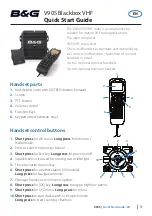
MDS 05-4846A01, Rev. F
SD Series Technical Manual
55
•
Destination IP Port
—Used to specify a port number for the RJ-45
modular connector on the connected device (typically a PC). Port
numbers below 2000 should be avoided, as some are reserved for
special applications in data networks.
•
TCP Server IP Address
—IP address of the TCP server being used.
•
TCP Server IP Port
—Port number of the TCP server being used.
•
Connection Timeout
—Used to specify a time in seconds, after
which the connection will be dropped following a period of inac-
tivity.
•
Persistent Connection
—When set to
Yes
, the connection to the
server is maintained continuously, even during periods of inactiv-
ity.
Understanding the Use of Virtual Radio Channels (VRCs)
The use of
Virtual Radio Channels (VRCs)
may require additional
explanation for new users of the feature. VRCs allow over-the-air data
to be directed to specific interface ports (IP or Serial) on the radio. Con-
ceptually, this can be pictured as creating “pipes” for delivery of data to
the desired radio interfaces.
VRC works by associating data from a specific port (IP and Serial) with
a VRC channel number (1, 2, or 3). Each port at the receiving end then
filters incoming data based on the associated VRC number.
NOTE:
The Virtual Radio Channel (VRC) feature only works on
radios configured to operate in Packet Mode.
To create the “pipes” that direct data to the desired ports, a route must
be established using the IP Payload Configuration Menu (or the
COM1/COM2 Settings Menu for serial data). The default setting is to
listen to
all
channels.) The
Talk on
parameter is used to specify the VRC
used for sending the data stream out, while the
Listen to
parameter spec-
ifies the VRC(s) for incoming data. Use of these parameters is described
below.
Any combination of the three VRC numbers may be entered in the selec-
tion fields. Figure 27 illustrates the relationship between the VRC set-
tings and the routing of data between units.
















































